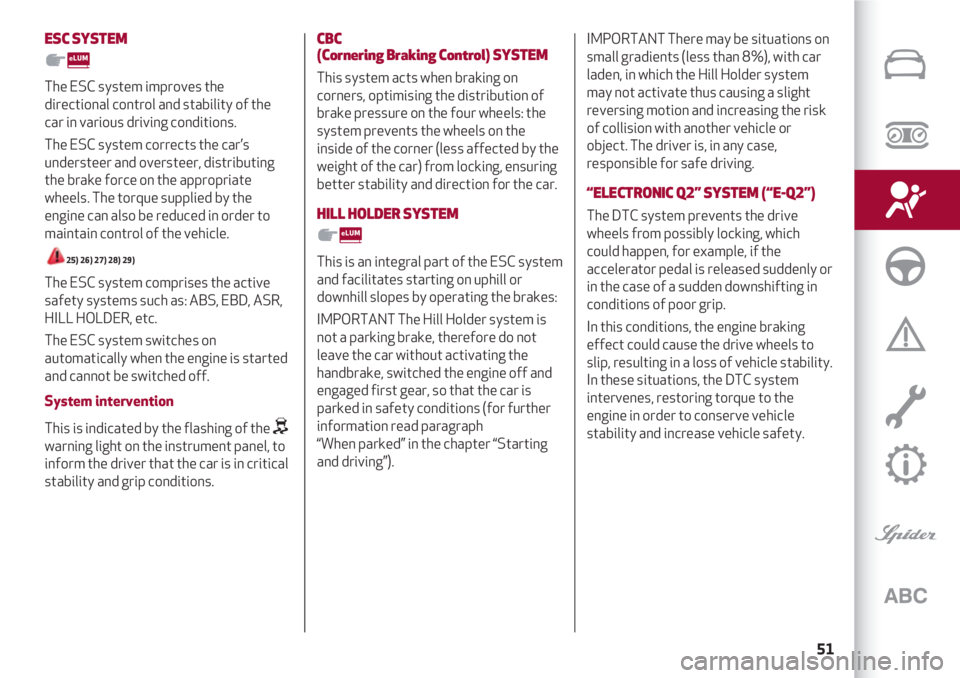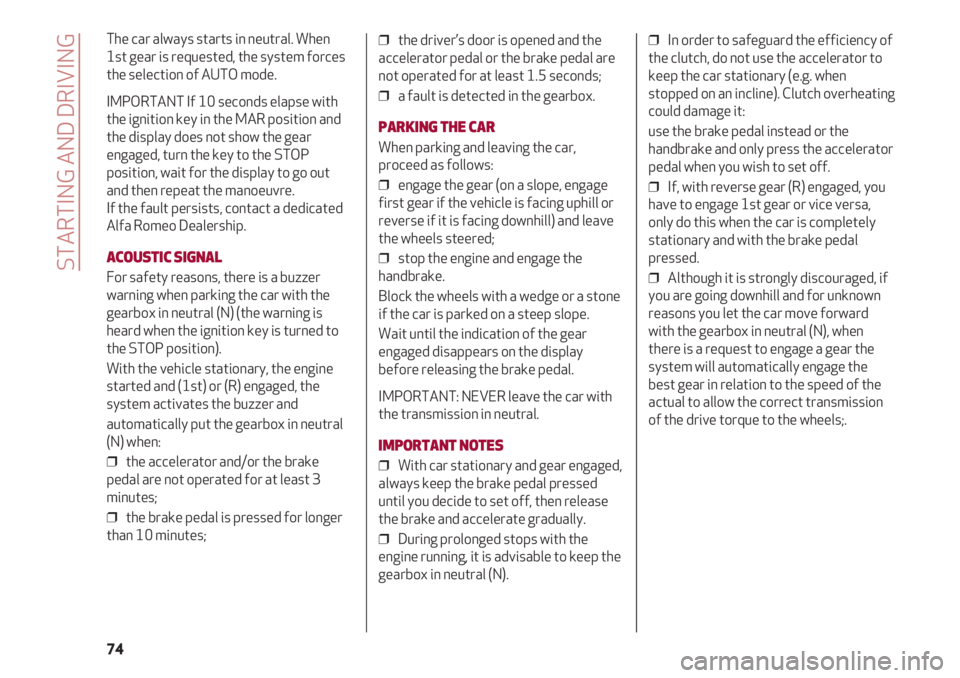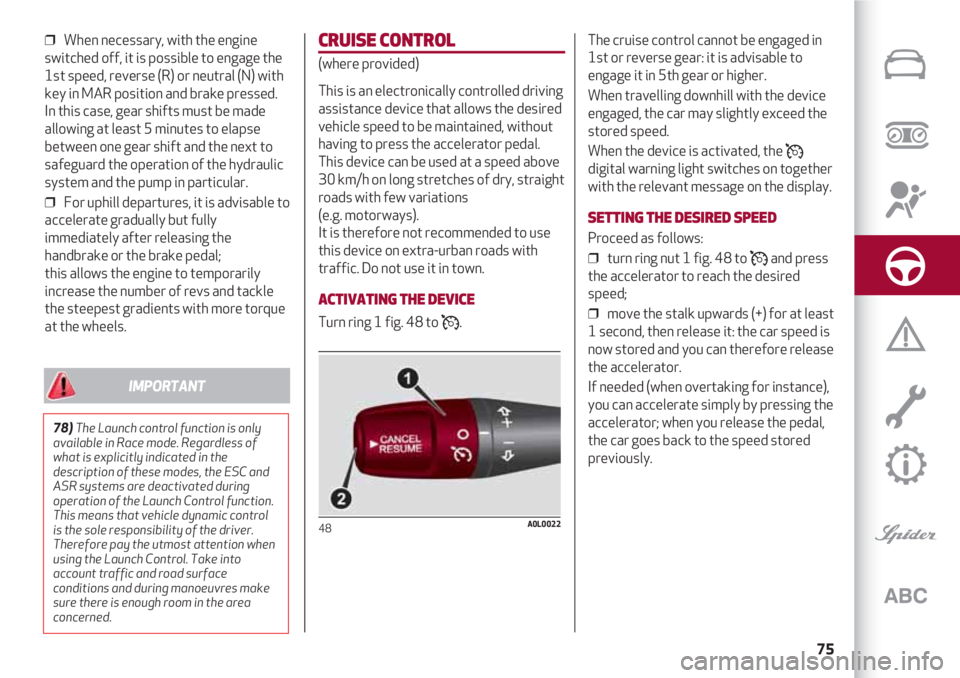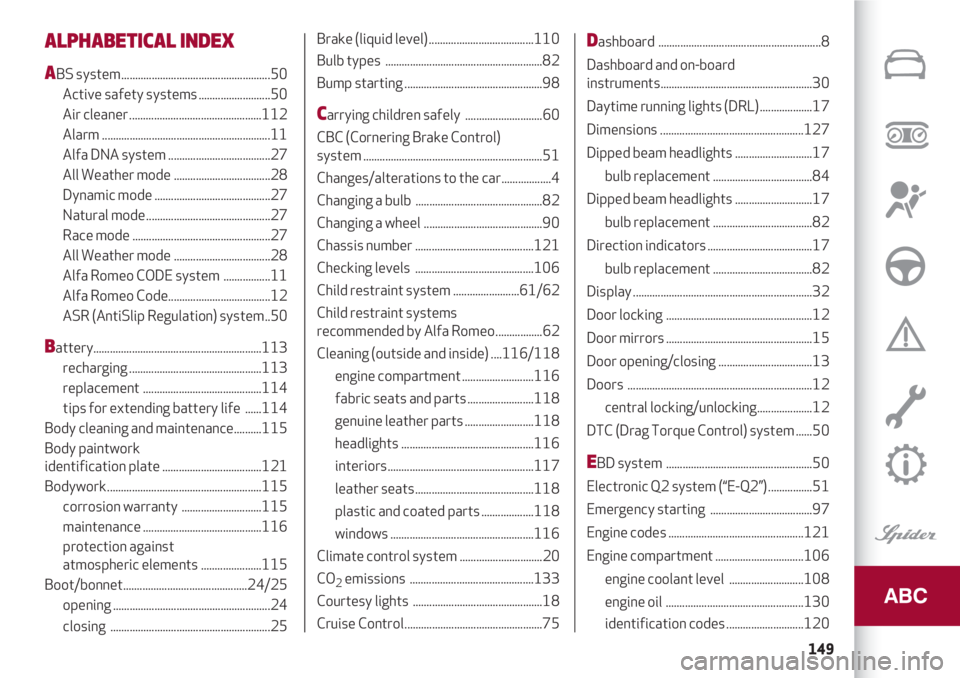wheel torque Alfa Romeo 4C 2020 Owner handbook (in English)
[x] Cancel search | Manufacturer: ALFA ROMEO, Model Year: 2020, Model line: 4C, Model: Alfa Romeo 4C 2020Pages: 156, PDF Size: 3.06 MB
Page 52 of 156

SAFETY
50
ACTIVE SAFETY SYSTEMS
ABS SYSTEM
This system, which is an integral part of
the braking system, prevents one or
more wheels from locking and slipping in
all road surface conditions, irrespective
of the intensity of the braking action,
ensuring that the vehicle can be
controlled even during emergency
braking and optimising stopping
distances.
System intervention
The driver can feel that the ABS system
has come into action because the brake
pedal pulsates slightly and the system
gets noisier: this is entirely normal with
the system operating.
30) 31) 32) 33) 34) 35) 36)
ASR (AntiSlip Regulation) SYSTEM
37) 38) 39)
This is an integral part of the ESC system
and automatically operates in the event
of one or both drive wheels slipping, loss
of grip on wet roads (aquaplaning) and
acceleration on slippery, snowy or icy
roads, etc.
System intervention
The system intervenes on the engine
power and the brakes.
It is indicated by the flashing of the
warning light on the instrument panel,
to inform the driver that the vehicle is
in critical stability and grip conditions.
HBA (Hydraulic Brake Assist) SYSTEM
40) 41) 42)
The HBA system is designed to improve
the car’s braking capacity during
emergency braking: the HBA system
therefore completes the ABS system.
Maximum assistance from the HBA
system is obtained by continuously
pressing the brake pedal very quickly.
EBD SYSTEM
The EBD system is an integral part of the
ESC system and intervenes during
braking, distributing the brake force
optimally between front and rear wheels.
This guarantees greater braking stability
for the car, preventing sudden locking of
the rear wheels and the consequent
instability of the car.
DTC (Drag Torque Control) SYSTEM
This is an integral part of the ABS
system and intervenes in the case of
sudden downshifting, or during braking
when the ABS intervenes, restoring
torque to the engine and thus preventing
excessive drag at the drive wheels, which
may lead the wheels to lock and a loss of
car stability, above all in low-grip
conditions.
Page 53 of 156

51
ESC SYSTEM
The ESC system improves the
directional control and stability of the
car in various driving conditions.
The ESC system corrects the car’s
understeer and oversteer, distributing
the brake force on the appropriate
wheels. The torque supplied by the
engine can also be reduced in order to
maintain control of the vehicle.
25) 26) 27) 28) 29)
The ESC system comprises the active
safety systems such as: ABS, EBD, ASR,
HILL HOLDER, etc.
The ESC system switches on
automatically when the engine is started
and cannot be switched off.
System intervention
This is indicated by the flashing of the
warning light on the instrument panel, to
inform the driver that the car is in critical
stability and grip conditions.
CBC
(Cornering Braking Control) SYSTEM
This system acts when braking on
corners, optimising the distribution of
brake pressure on the four wheels: the
system prevents the wheels on the
inside of the corner (less affected by the
weight of the car) from locking, ensuring
better stability and direction for the car.
HILL HOLDER SYSTEM
This is an integral part of the ESC system
and facilitates starting on uphill or
downhill slopes by operating the brakes:
IMPORTANT The Hill Holder system is
not a parking brake, therefore do not
leave the car without activating the
handbrake, switched the engine off and
engaged first gear, so that the car is
parked in safety conditions (for further
information read paragraph
“When parked” in the chapter “Starting
and driving”).
IMPORTANT There may be situations on
small gradients (less than 8%), with car
laden, in which the Hill Holder system
may not activate thus causing a slight
reversing motion and increasing the risk
of collision with another vehicle or
object. The driver is, in any case,
responsible for safe driving.
“ELECTRONIC Q2” SYSTEM (“E-Q2”)
The DTC system prevents the drive
wheels from possibly locking, which
could happen, for example, if the
accelerator pedal is released suddenly or
in the case of a sudden downshifting in
conditions of poor grip.
In this conditions, the engine braking
effect could cause the drive wheels to
slip, resulting in a loss of vehicle stability.
In these situations, the DTC system
intervenes, restoring torque to the
engine in order to conserve vehicle
stability and increase vehicle safety.
Page 76 of 156

STARTING AND DRIVING
74
The car always starts in neutral. When
1st gear is requested, the system forces
the selection of AUTO mode.
IMPORTANT If 10 seconds elapse with
the ignition key in the MAR position and
the display does not show the gear
engaged, turn the key to the STOP
position, wait for the display to go out
and then repeat the manoeuvre.
If the fault persists, contact a dedicated
Alfa Romeo Dealership.
ACOUSTIC SIGNAL
For safety reasons, there is a buzzer
warning when parking the car with the
gearbox in neutral (N) (the warning is
heard when the ignition key is turned to
the STOP position).
With the vehicle stationary, the engine
started and (1st) or (R) engaged, the
system activates the buzzer and
automatically put the gearbox in neutral
(N) when:
❒ the accelerator and/or the brake
pedal are not operated for at least 3
minutes;
❒ the brake pedal is pressed for longer
than 10 minutes;❒ the driver’s door is opened and the
accelerator pedal or the brake pedal are
not operated for at least 1.5 seconds;
❒ a fault is detected in the gearbox.
PARKING THE CAR
When parking and leaving the car,
proceed as follows:
❒ engage the gear (on a slope, engage
first gear if the vehicle is facing uphill or
reverse if it is facing downhill) and leave
the wheels steered;
❒ stop the engine and engage the
handbrake.
Block the wheels with a wedge or a stone
if the car is parked on a steep slope.
Wait until the indication of the gear
engaged disappears on the display
before releasing the brake pedal.
IMPORTANT: NEVER leave the car with
the transmission in neutral.
IMPORTANT NOTES
❒ With car stationary and gear engaged,
always keep the brake pedal pressed
until you decide to set off, then release
the brake and accelerate gradually.
❒ During prolonged stops with the
engine running, it is advisable to keep the
gearbox in neutral (N).❒ In order to safeguard the efficiency of
the clutch, do not use the accelerator to
keep the car stationary (e.g. when
stopped on an incline). Clutch overheating
could damage it:
use the brake pedal instead or the
handbrake and only press the accelerator
pedal when you wish to set off.
❒ If, with reverse gear (R) engaged, you
have to engage 1st gear or vice versa,
only do this when the car is completely
stationary and with the brake pedal
pressed.
❒ Although it is strongly discouraged, if
you are going downhill and for unknown
reasons you let the car move forward
with the gearbox in neutral (N), when
there is a request to engage a gear the
system will automatically engage the
best gear in relation to the speed of the
actual to allow the correct transmission
of the drive torque to the wheels;.
Page 77 of 156

75
❒ When necessary, with the engine
switched off, it is possible to engage the
1st speed, reverse (R) or neutral (N) with
key in MAR position and brake pressed.
In this case, gear shifts must be made
allowing at least 5 minutes to elapse
between one gear shift and the next to
safeguard the operation of the hydraulic
system and the pump in particular.
❒ For uphill departures, it is advisable to
accelerate gradually but fully
immediately after releasing the
handbrake or the brake pedal;
this allows the engine to temporarily
increase the number of revs and tackle
the steepest gradients with more torque
at the wheels.CRUISE CONTROL
(where provided)
This is an electronically controlled driving
assistance device that allows the desired
vehicle speed to be maintained, without
having to press the accelerator pedal.
This device can be used at a speed above
30 km/h on long stretches of dry, straight
roads with few variations
(e.g. motorways).
It is therefore not recommended to use
this device on extra-urban roads with
traffic. Do not use it in town.
ACTIVATING THE DEVICE
Turn ring 1 fig. 48 to .
48A0L0022
78)The Launch control function is only
available in Race mode. Regardless of
what is explicitly indicated in the
description of these modes, the ESC and
ASR systems are deactivated during
operation of the Launch Control function.
This means that vehicle dynamic control
is the sole responsibility of the driver.
Therefore pay the utmost attention when
using the Launch Control. Take into
account traffic and road surface
conditions and during manoeuvres make
sure there is enough room in the area
concerned.
IMPORTANT
The cruise control cannot be engaged in
1st or reverse gear: it is advisable to
engage it in 5th gear or higher.
When travelling downhill with the device
engaged, the car may slightly exceed the
stored speed.
When the device is activated, the
digital warning light switches on together
with the relevant message on the display.
SETTING THE DESIRED SPEED
Proceed as follows:
❒ turn ring nut 1 fig. 48 to and press
the accelerator to reach the desired
speed;
❒ move the stalk upwards (+) for at least
1 second, then release it: the car speed is
now stored and you can therefore release
the accelerator.
If needed (when overtaking for instance),
you can accelerate simply by pressing the
accelerator; when you release the pedal,
the car goes back to the speed stored
previously.
Page 151 of 156

149
ALPHABETICAL INDEX
ABS system......................................................50
Active safety systems ..........................50
Air cleaner ................................................112
Alarm .............................................................11
Alfa DNA system .....................................27
All Weather mode ...................................28
Dynamic mode ..........................................27
Natural mode .............................................27
Race mode ..................................................27
All Weather mode ...................................28
Alfa Romeo CODE system .................11
Alfa Romeo Code.....................................12
ASR (AntiSlip Regulation) system..50
Battery.............................................................113
recharging ................................................113
replacement ...........................................114
tips for extending battery life ......114
Body cleaning and maintenance..........115
Body paintwork
identification plate ....................................121
Bodywork........................................................115
corrosion warranty .............................115
maintenance ...........................................116
protection against
atmospheric elements ......................115
Boot/bonnet.............................................24/25
opening .........................................................24
closing ..........................................................25Brake (liquid level) ......................................110
Bulb types .........................................................82
Bump starting ..................................................98
Carrying children safely ............................60
CBC (Cornering Brake Control)
system .................................................................51
Changes/alterations to the car..................4
Changing a bulb ..............................................82
Changing a wheel ...........................................90
Chassis number ...........................................121
Checking levels ...........................................106
Child restraint system ........................61/62
Child restraint systems
recommended by Alfa Romeo.................62
Cleaning (outside and inside) ....116/118
engine compartment ..........................116
fabric seats and parts ........................118
genuine leather parts .........................118
headlights ................................................116
interiors.....................................................117
leather seats...........................................118
plastic and coated parts ...................118
windows ....................................................116
Climate control system ..............................20
CO
2emissions .............................................133
Courtesy lights ...............................................18
Cruise Control..................................................75
Dashboard ...........................................................8
Dashboard and on-board
instruments.......................................................30
Daytime running lights (DRL) ...................17
Dimensions ....................................................127
Dipped beam headlights ............................17
bulb replacement ....................................84
Dipped beam headlights ............................17
bulb replacement ....................................82
Direction indicators ......................................17
bulb replacement ....................................82
Display .................................................................32
Door locking .....................................................12
Door mirrors .....................................................15
Door opening/closing ..................................13
Doors ...................................................................12
central locking/unlocking....................12
DTC (Drag Torque Control) system ......50
EBD system .....................................................50
Electronic Q2 system (“E-Q2”) ................51
Emergency starting .....................................97
Engine codes .................................................121
Engine compartment ................................106
engine coolant level ...........................108
engine oil ..................................................130
identification codes ............................120